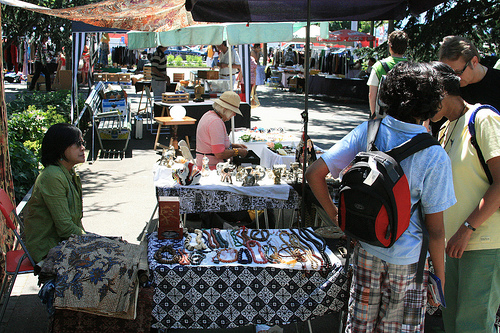When you take your business on the road to sell products at flea markets, conventions, and other events, you have the opportunity to reach new customers who have never been to your store. Going on the road, however, requires some extra steps in order to accept payments. Unless you only take cash, you’ll need to find a payment app or mobile terminal that works well for you and your customers.
Before you spend your time and money on a new point-of-sale system, learn about these four popular options. One or more of them should match your needs well.
Android Pay

Image via Flickr by jay8085
Android Pay lets your customers use their smartphones to pay for purchases. The app stores credit card information securely so a customer only has to unlock his or her smartphone and tap it to your point-of-sale terminal.
A lot of consumers prefer using Android Pay and similar apps because they don’t want to carry credit cards. Many see payment apps as a more secure alternative to credit cards since the apps require a PIN or fingerprint ID to use.
The only downside to Android Pay is that you will need a point-of-sale terminal that uses near-field communication. Luckily, many of today’s portable terminals already come with near-field features. Once you connect them to your mobile device, you can accept a customer’s payment even when you’re not in your store.
Samsung Pay
Samsung Pay has a lot in common with Android Pay. It lets customers pay with their smartphones, and it requires a point-of-sale terminal that uses near-field communication. Samsung Pay, however, is only available to people who own Samsung smartphones. Considering that the Samsung Galaxy S7 edge’s long battery life has helped make it one of the most popular mobile devices of 2016, accepting Samsung Pay will make it easier for you to take payments from many of your customers.
Some of your potential customers will prefer Samsung Pay because it offers extra security features. The app takes advantage of Samsung’s KNOX technology and lets owners disable their devices if their smartphones ever get lost or stolen.
Square Register
Square revolutionized mobile payments with its portable credit card reader. The company has grown a lot over recent years, though, so you can get much more than a small reader that plugs into your smartphone. Now Square makes readers that accept credit cards with EMV chips. It even makes a near-field communication device that will accept payments from smartphones.
The advantage of choosing Square Register is that it works with practically any type of credit card. Your customers don’t need a Square account to pay for their purchases. It works like a standard point-of-sale terminal that doesn’t restrict the types of credit card accounts you can accept. That flexibility makes it easier for you to take payments from more customers.
PayPal
PayPal has been around for so long (since 1998) that over 184 million people have active accounts. It’s such a popular online payment option that it makes sense for you to accept it in person, too. You just need to make sure your business has an account to accept deposits from PayPal.
PayPal makes a near-field communication terminal that accepts payments from EMV chip cards and smartphones. It gets a little complicated, though, when your customer wants to pay directly from his or her PayPal account. Instead of just tapping a smartphone to the terminal, your customer has to log in to his or her account and “check in” to your store.
The process is cumbersome enough that you may have to spend a couple of minutes going through it with new customers who have never used it before. Still, it never hurts to accept more payment options, even if it slows you down a little on busy days.
Taking your merchandise on the road is a great way to meet new customers and improve your store’s visibility. To make the most of the opportunity, though, you’ll need some or all of these easy ways to get paid on the go.
